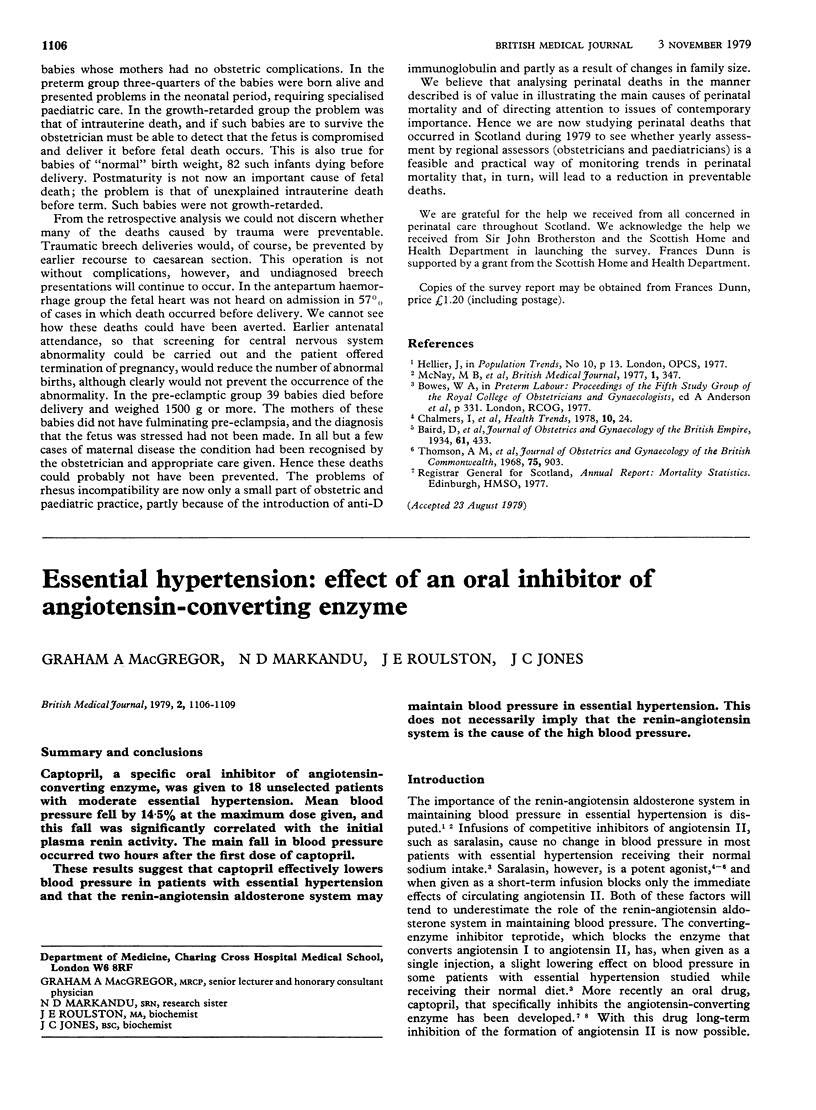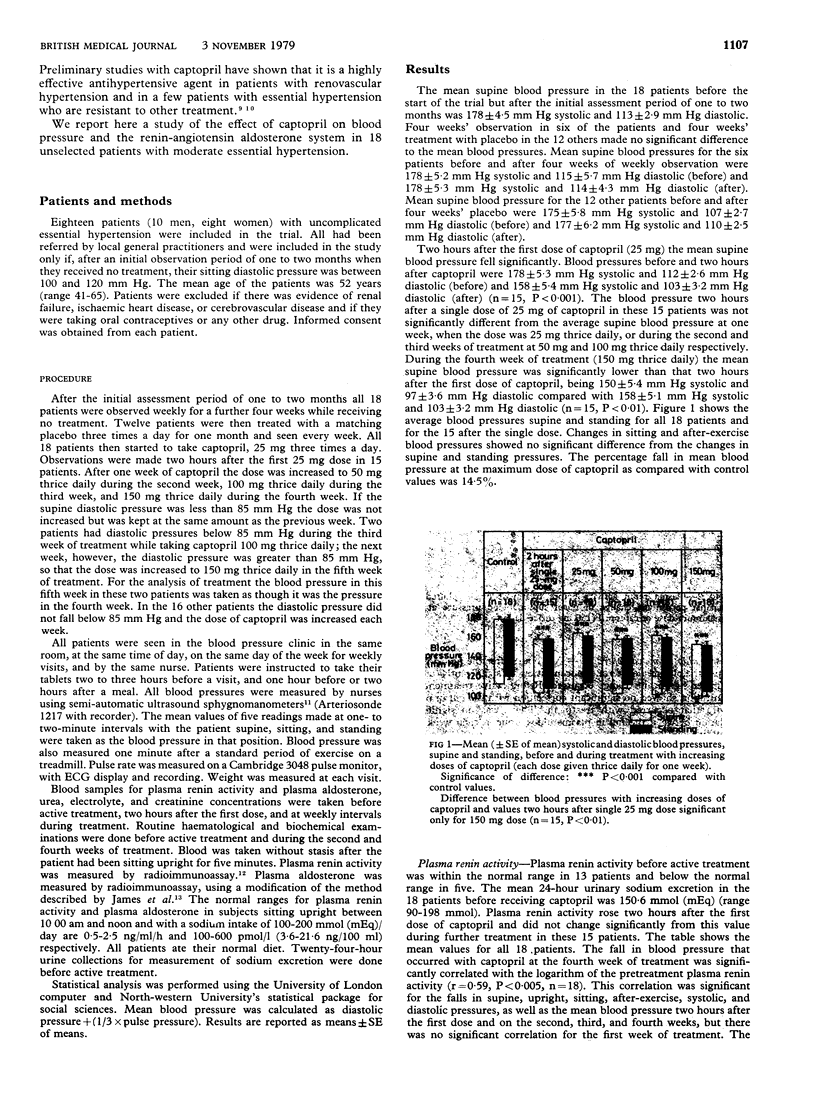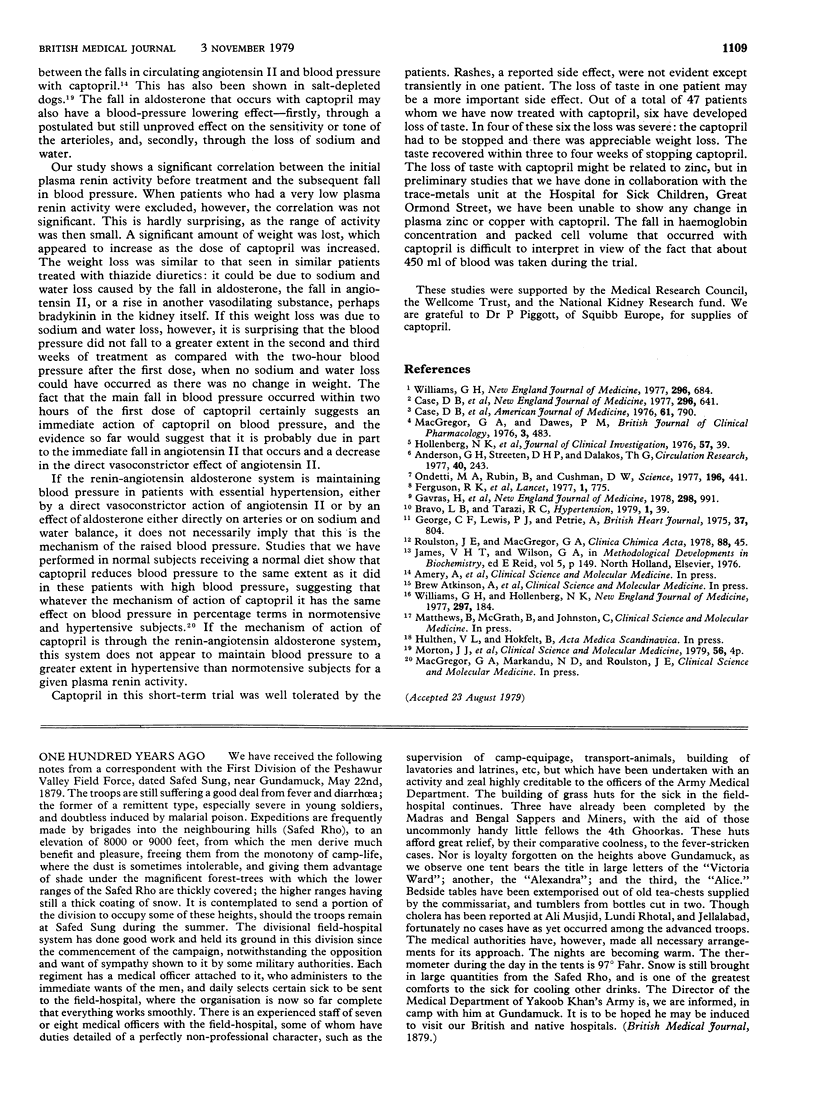Abstract
Captopril, a specific oral inhibitor of angiotensin-converting enzyme, was given to 18 unselected patients with moderate essential hypertension. Mean blood pressure fell by 14.5% at the maximum dose given, and this fall was significantly correlated with the initial plasma renin activity. The main fall in blood pressure occurred two hours after the first dose of captopril. These results suggest that captopril effectively lowers blood pressure in patients with essential hypertension and that the renin-angiotensin aldosterone system may maintain blood pressure in essential hypertension. This does not necessarily imply that the renin-angiotensin system is the cause of the high blood pressure.
Full text
PDF



Selected References
These references are in PubMed. This may not be the complete list of references from this article.
- Anderson G. H., Jr, Streeten D. H., Dalakos T. G. Pressor response to 1-sar-8-ala-angiotensin II (saralasin) in hypertensive subjects. Circ Res. 1977 Mar;40(3):243–250. doi: 10.1161/01.res.40.3.243. [DOI] [PubMed] [Google Scholar]
- Bravo E. L., Tarazi R. C. Converting enzyme inhibition with an orally active compound in hypertensive man. Hypertension. 1979 Jan-Feb;1(1):39–46. doi: 10.1161/01.hyp.1.1.39. [DOI] [PubMed] [Google Scholar]
- Case D. B., Wallace J. M., Keim H. J., Weber M. A., Drayer J. I., White R. P., Sealey J. E., Laragh J. H. Estimating renin participation in hypertension: superiority of converting enzyme inhibitor over saralasin. Am J Med. 1976 Nov;61(5):790–796. doi: 10.1016/0002-9343(76)90160-1. [DOI] [PubMed] [Google Scholar]
- Ferguson R. K., Turini G. A., Brunner H. R., Gavras H., McKinstry D. N. A specific orally active inhibitor of angiotensin-converting enzyme in man. Lancet. 1977 Apr 9;1(8015):775–778. doi: 10.1016/s0140-6736(77)92958-0. [DOI] [PubMed] [Google Scholar]
- Gavras H., Brunner H. R., Turini G. A., Kershaw G. R., Tifft C. P., Cuttelod S., Gavras I., Vukovich R. A., McKinstry D. N. Antihypertensive effect of the oral angiotensin converting-enzyme inhibitor SQ 14225 in man. N Engl J Med. 1978 May 4;298(18):991–995. doi: 10.1056/NEJM197805042981803. [DOI] [PubMed] [Google Scholar]
- George C. F., Lewis P. J., Petrie A. Clinical experience with use of ultrasound sphygmomanometer. Br Heart J. 1975 Aug;37(8):804–807. doi: 10.1136/hrt.37.8.804. [DOI] [PMC free article] [PubMed] [Google Scholar]
- Hollenberg N. K., Williams G. H., Burger B., Ishikawa I., Adams D. F. Blockade and stimulation of renal, adrenal, and vascular angiotensin II receptors with 1-Sar, 8-Ala angiotensin II in normal man. J Clin Invest. 1976 Jan;57(1):39–46. doi: 10.1172/JCI108266. [DOI] [PMC free article] [PubMed] [Google Scholar]
- MacGregor G. A., Dawes P. M. Agonist and antagonist effects of Sar1-ala8--angiotensin II in salt-loaded and salt-depleted normal man. Br J Clin Pharmacol. 1976 Jun;3(3):483–487. doi: 10.1111/j.1365-2125.1976.tb00625.x. [DOI] [PMC free article] [PubMed] [Google Scholar]
- Ondetti M. A., Rubin B., Cushman D. W. Design of specific inhibitors of angiotensin-converting enzyme: new class of orally active antihypertensive agents. Science. 1977 Apr 22;196(4288):441–444. doi: 10.1126/science.191908. [DOI] [PubMed] [Google Scholar]
- Roulston J. E., MacGregor G. A. Measurement of plasma renin activity by radioimmunoassay after prolonged cold storage. Clin Chim Acta. 1978 Aug 15;88(1):45–48. doi: 10.1016/0009-8981(78)90147-x. [DOI] [PubMed] [Google Scholar]
- Williams G. H., Hollenberg N. K. Accentuated vascular and endocrine response to SQ 20881 in hypertension. N Engl J Med. 1977 Jul 28;297(4):184–188. doi: 10.1056/NEJM197707282970404. [DOI] [PubMed] [Google Scholar]


